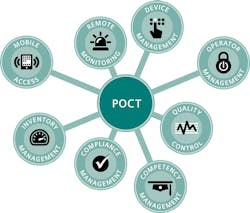The role of calibration verification/linearity in the POCT market
If you are one of the many who have purchased an instrument for point-of-care testing (POCT), this is a very legitimate question. POCT user manuals will typically state in one form or another that the linearity of the instrument should be checked before the instrument is used for patients for the first time. The user manual may also refer to calibration verification in lieu of linearity, or it may refer to both terms. And in many instances, but not all, the manufacturer may include a calibration verification/linearity kit with the initial shipment of the test system to be used upon initial set-up. The user manual will also generally state that subsequent linearity tests are to be determined by the facility operating the system.
So, the question above should perhaps be reformulated as two questions. Once the test system is calibrated, controls are set and run, and calibration has been verified and/or linearity has been established: “Is calibration verification/linearity required on my POCT system moving forward? And, what exactly is the difference between calibration verification and linearity?” Let’s tackle the second question, first.
Calibration verification and linearity
Calibration verification is the process of assaying materials of known concentration in the same manner as patient samples to assure that the test system is accurately measuring samples throughout the reportable range of the instrument—reportable range being the range of the test results for an analyte, from minimum to maximum, which the instrument test system can accurately measure. Per Clinical Laboratory Improvement Amendment (CLIA) guidelines, at least three samples (low, middle and high) spanning the reportable range of the test are run as unknowns (performed in normal test mode, not calibration mode), and the values obtained are compared to the known values of the calibration verification material. If the calibration verification confirms that calibration settings are valid for a specified method, no further calibration actions are necessary. Calibration verification is to be performed every six months, or more often if specified in the user’s test system instructions, the facility’s QC protocol, and under circumstances outlined in CLIA 493.1255(b)(3).
Linearity, as defined by CLSI’s EP-06-A guideline, is as follows: “The ability (within a given range) to provide results that are directly proportional to the concentration (amount) of the analyte in the test sample.” Linearity studies are performed to determine the linear reportable range for an analyte. Linearity is achieved when measured results are directly proportional to the concentration of the analyte in the test sample, within a given range.
One reason one may find the term linearity so frequently used in analyzer package inserts is that before the final CLIA regulations were published in 2003, laboratories were required to perform linearity studies every six months for quantitative high complexity tests. Linearity studies, as such, are no longer required by CLIA, as calibration verification has basically replaced the term and process of linearity studies. Please be aware, however, that linearity, as defined above by CLSI’s EP06-A guideline, is still recommended and is considered Good Laboratory Practice.
Moving forward, please note also that all testing, regardless of where performed, including POCT, is regulated by CLIA. CLIA section 493.1255 requires, among other things, that laboratories verify calibration. This section also requires at a minimum that laboratories follow the manufacturer’s protocol for calibration verification.
Waived and nonwaived testing
Which brings us to the first question: “Is calibration verification required on my POCT system?”
All laboratory clinical tests, POCT included, at a minimum are regulated by CLIA and are classified as either waived or nonwaived. Nonwaived tests are further classified as moderately complex or high complexity.
The majority of POCT systems, defined as medical diagnostics testing that is performed outside of the clinical lab in close proximity to where the patient is receiving care, are classified by CLIA as waived. As defined by CLIA, waived tests are simple, easy-to-run tests with a negligible risk for an incorrect result. A CLIA-waived test system by definition is cleared for home use by the U.S. Food and Drug Administration (FDA) and requires no training for the end user. Per CLIA, COLA, The Joint Commission, and CAP, calibration verification is not required for waived testing. The only requirement for waived tests is that the user follow, at a minimum, the manufacturer’s instructions. Be aware, however, that state regulations can supersede CLIA guidelines. In Massachusetts, for example, if a doctor’s office lab is state-licensed, it is required to perform calibration verification on waived tests.
Test systems, including POCT, not categorized by the FDA as waived are considered nonwaived. Per CLIA guidelines, calibration verification is required on nonwaived tests. Nonwaived tests are further classified as moderately complex or high complexity. Moderately complex nonwaived tests are performed in a laboratory setting on automated clinical lab equipment with qualified personnel who possess skills in the reading and interpretation of quantitative results. QA, QC, calibration, and proficiency may be required as well. POC tests that are classified as nonwaived fall under this moderately complex category and, as stated above, calibration verification will be required.
High complexity nonwaived systems differ from moderately complex tests, as high complexity tests (such as cytology, flow cytometry, PCR, gel electrophoresis, MRI, and CT scans) typically are not quantitative and as such may require substantial training and/or specialized knowledge in the preparation, process, and interpretation of results. Even though at this point POCT systems do not fall under the high complexity heading, understanding this distinction is important. That is because, if a site develops its own procedure or chooses to modify its waived (or moderately complex) protocol, the test automatically bumps up from waived to nonwaived high complexity status, and calibration verification, among other procedures, may be required in order to be fully compliant by state and federal regulations. Modification examples could include not following manufacturers’ directions or performing tests on sample types not specified in the manufacturers labeling.
Moving forward, how do end users determine the complexity designation of their POCT system? The manufacturer’s user manual or package insert should state whether the test system is waived or nonwaived. If you still cannot locate the necessary information, you can go online, call the manufacturer directly, or utilize one or more of these FDA and CMS
web-based resources:
- www.accessdata.fda.gov/scripts/cdrh/cfdocs/cfCLIA/search.cfm
- www.accessdata.fda.gov/scripts/cdrh/cfdocs/cfclia/testswaived.cfm
- www.accessdata.fda.gov/scripts/cdrh/cfdocs/cfclia/analyteswaived.cfm
To sum up: “POCT” is simply an acronym that is used to describe the location where testing is to be performed, such as at bedside or near the site of patient care. The complexity designation of a POCT, waived or nonwaived, categorizes the test so that proper quality control and regulatory procedures can be dictated and followed per the designation. Calibration verification, though not required by CLIA on waived tests systems, is required on nonwaived tests and under special circumstances with waived tests, including manufacturer’s directive and if states, municipalities, or other regulatory and accreditation agencies require it. Linearity, as defined above, is not required by CLIA but is recommended and is considered Good Laboratory Practice.
While it is true that the vast majority of POCT systems today are waived and thus typically do not require calibration verification, nonwaived designation of POCT is sure to increase as current and future healthcare requirements and advances in technology will allow for decreased instrument footprints, an increase in turnaround time and throughput, ease of use, expanded instrument quantitative data capabilities, and thus the requirement of calibration verification.
Glenn Mitchell serves as a National Accounts Manager for AUDIT MicroControls. AUDIT supplies calibration verification and daily quality controls to the clinical laboratory market.


